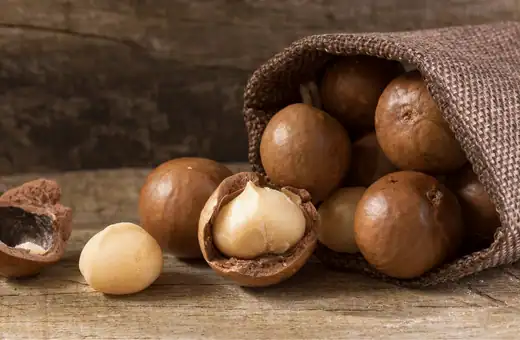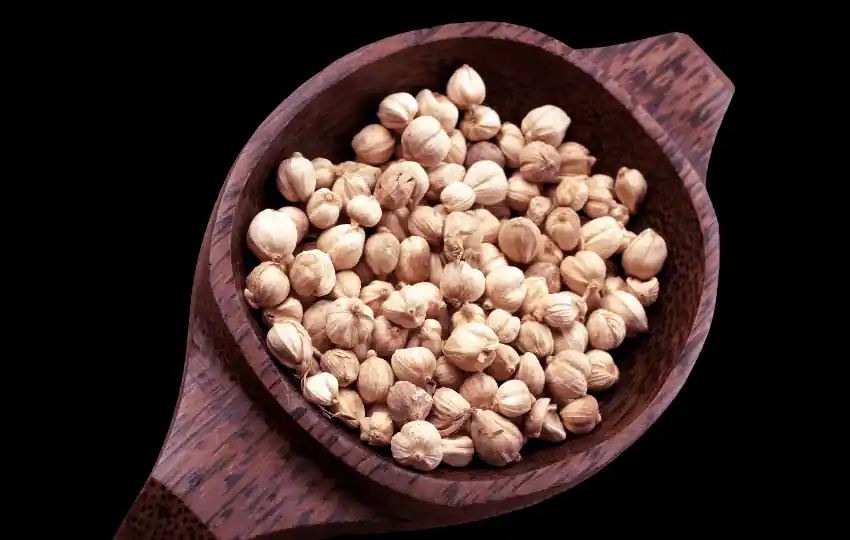Candlenuts are a popular ingredient in many Asian dishes, but they can often be hard to find.
Fortunately, there are several great candlenut substitutes, allowing cooks to create delicious meals without the hassle of tracking down this rare ingredient.
In this blog, we will explore some of the best alternatives for candlenuts, including macadamia nuts, cashew nuts, and almonds.
We’ll also discuss the best ways to use these ingredients in place of candlenuts for a successful dish. With this information, you’ll be able to create delicious dishes with ease using any of these great alternatives.
So let’s get started!
What are candlenuts, and What is candlenut used for in cooking?
Candlenuts, also known as kemiri in Indonesia, is a type of nut native to Southeast Asia and parts of the South Pacific. The nuts have an oily texture and sweet flavor that make them popular for cooking.
Moreover, They contain high levels of mono-saturated fat and are rich in vitamins A and E, which makes them a healthy oil alternative for cooking.
Candlenuts are commonly used as a thickening agent in many traditional recipes from the region, such as Malaysian nasi lemak, Indonesian sambal, and Balinese brenebon soup.
The nuts can also be toasted, ground into a paste, and used as a base for sauces.
They may be used in place of other fats and oils, such as coconut oil, for light stir-fries or to add richness to a dish. Candlenuts can be found at Asian grocery stores or online.
Best Candlenut substitutes you can use
1. Macadamia nuts – a good candlenut substitute
Macadamia nuts are a great substitute for Candlenuts.
Not only do they have a similar nutty flavor, but they also contain healthy monounsaturated fats, which can help to lower cholesterol and bad LDL levels in the body.

They are also an excellent source of dietary fiber, which helps to promote better digestion and detoxification of the body.
Finally, these tasty nuts can be added to salads or used as a snack on their own for a healthier, more delicious alternative to Candlenuts.
2. Brazil nuts
Brazil nuts are higher in protein and fiber, making them a healthier choice. They also have a mild nutty flavor that can easily complement many recipes.
Furthermore, they lend themselves to both sweet and savory dishes, making them versatile and great for adding a crunchy texture to your meal.
So, if you’re looking for a unique take on pesto sauce or salad dressing, try using Bazil nuts instead of Candlenuts!
When selecting Brazil nuts, look for ones that are plump and unbroken with no visible signs of mold or discoloration.
Store the shelled nuts in an airtight container in a cool, dry place. For best results, use them within 6 months of purchase.
3. Candlenut substitute cashew nuts
When making sambal, you may want to consider using cashew nuts instead of candlenuts.
Cashew nuts are more commonly used in Indian cooking and have a lighter flavor than the stronger, more pungent candlenuts.
The texture is also much softer and can be processed into a smooth paste that gives sambals a creamy consistency.
When substituting cashews for candlenuts in sambal recipes, it is best to use raw, unsalted cashews since they provide the best texture and flavor.
You may need to adjust seasoning levels when using this substitution as cashews do not have quite as strong of a flavor as candlenuts.
However, adding some extra chili powder or other spices will yield delicious results. For a richer, creamier sambal, try grinding up the roasted cashews before adding them to the mix.
This will give the dish a luxurious texture and even more flavor.
4. Hazelnuts
Hazel nuts are an excellent substitute for candlenuts in certain recipes. They are slightly sweeter and have a more delicate flavor than candlenuts, but they can still provide that nutty element desired in many dishes.
Hazel nuts may also be used instead of other nuts because they are less expensive and easier to find than some others.
The texture of the hazel nut is smoother and creamier than the crunchy texture of a candlenut, making it perfect for baking applications or even as a topping for ice creams or desserts.
When substituting, remember that hazelnuts may require more processing to obtain a finer consistency than what you would get from candlenuts.
Additionally, using peeled hazelnuts will give you better results when cooking or baking.
So if you’re running low on candlenuts, reach for the bag of hazelnuts instead! They may just be what your recipe needs to make it perfect.
5. Pine nuts – an excellent candlenut alternative
Candlenuts have a distinct, pungent flavor that can be overpowering in some dishes. As an alternative, many cooks suggest using pine nuts as a substitute for candlenuts.
While the flavors are different, both varieties of nuts provide a rich texture and slightly sweet taste that is ideal for certain recipes.

Pine nuts also have higher levels of healthy fats than candlenuts which makes them a nutritious addition to any dish. They can be used in pestos, dressings, sauces, and other savory recipes with great results.
Try substituting pine nuts the next time you’re cooking—you might just find yourself reaching for them again and again.
6. Almonds – for gluten-free baking
Almonds are a great gluten-free alternative to candlenuts, as they are high in protein, vitamin E, and dietary fiber.
Plus, almonds have a slightly sweet and nutty flavor that pairs well with many savory dishes. They are also packed with healthy fats, which help to keep your cholesterol levels balanced.
Almonds can be eaten raw or roasted, used in baking recipes, or blended into a paste for use as a spread or dip.
7. Palm oil- Nut-free Candlenut Alternative
Palm oil is a more sustainable, healthier option for your home cooking. It is lower in saturated fats and has no trans fat content.
Additionally, palm oil is an excellent cooking oil as it has a very high smoke point which makes it perfect for frying without releasing harmful carcinogens into the air.
Finally, palm oil is renewable and can be sustainably produced without damaging the environment.
With all these benefits combined, using palm oil instead of candlenuts could make a big difference to your family’s health and well-being. So, make the switch today and start cooking with palm oil!
8. Coconut oil
A good nut-free alternative to candlenuts is to use coconut oil instead of it. Coconut oil has many health benefits, including being a great source of healthy fats and antioxidants.
Its light flavor also pairs well with other flavors like lemon or garlic for added flavor. It can be utilized as a substitute in many recipes calling for candlenuts, such as curries and stir-fries.
Read more: Coconut flakes substitutes
Conclusion on candlenut substitute
By understanding the flavor and texture of candlenuts, you can find a few good alternatives that will work well in any dish.
Macadamia nuts are especially popular for their mild flavor and creamy texture that is reminiscent of candlenuts.
Cashew nuts also have a similar flavor but with more crunchiness. Almonds also have a nutty flavor and can be used to replace candlenuts in some dishes.
When using macadamia or cashew nuts as a substitute for candlenuts, remember that they are softer than the original ingredient, so it may take longer to cook them until they are done.
Almonds, on the other hand, are more durable and can tolerate longer cooking times.
Overall, any of these substitutes for candlenuts will make a great addition to your recipes. Just ensure to adjust the cooking time if you decide to use macadamia or cashew nuts as a substitute.
With these tips and tricks, you’ll be capable of creating flavorful dishes without needing the original ingredient. So go ahead and try it!
FAQs on candlenut substitute
Q1. Is candlenut the same as macadamia?
Candle nuts are a nutritious and surprisingly versatile nut, often overlooked in terms of culinary uses. They are a relative of the macadamia nut, yielding a similar texture and flavor yet possessing their own unique advantages.
Candle nuts have a low glycemic index and high oil content that make them incredibly appealing for baking applications. They can also be used as an alternative to peanut butter as a source of protein and healthy fats; additionally, the oil produced from candle nuts has a longer shelf life than most nuts.
This natural treat is not only delicious but also offers plenty of health benefits, such as improved cardiovascular health, reduced LDL cholesterol, and blood pressure levels, and strengthened bones.
Altogether, candle nuts are a wonderful ingredient to incorporate into one’s diet for an added punch of nutrition.
However, they are not the same nut. Candle nuts have a much higher oil content than macadamias and tend to be smaller in size. They also have a slightly more bitter flavor and rougher texture compared to macadamias.
The candle nut is popular for its use as an edible oil in some parts of the world but is not a common ingredient in Western cuisine. Macadamias, on the other hand, are widely used in a variety of recipes and products.
While they may look similar, candle nuts and macadamias are two distinct varieties with different characteristics.
Q2. What is a kukui nut similar to?
Kukui nuts are similar to macadamia nuts. Both have a hard exterior shell and contain a rich, creamy interior that is loaded with vitamins and minerals. The flavor of kukui nut is often described as being buttery and slightly sweet, making it popular in many dishes worldwide.
The nut has been used for centuries in Hawaii as a traditional medicine, as well as for culinary purposes. Kukui nuts are often used in desserts, smoothies, and salads to add texture and flavor.
In addition to its edible uses, the kukui nut is also used to make various health and beauty products, including soaps, oils, lotions, and shampoos. The oil extracted from the nut is said to have healing properties and can be used to help soothe skin irritations and wounds.
Kukui nuts are an excellent source of protein, fiber, vitamins, minerals, and healthy fats that can help promote overall health.
Q3. Is a candlenut a walnut?
No, a candlenut is not a walnut. Candlenuts are native to Southeast Asia and are also known as kemiri, kukui, buah keras, or Kemiri nuts. Unlike walnuts which have an outer shell that needs to be removed in order to access the nut inside, candlenuts can be eaten whole and have a firm, waxy texture.
They are usually used to add flavor and texture to dishes such as curries and stews. Candlenuts can also be ground into a paste or dissolved in hot water, then strained for use as an emulsifier. The taste of the candlenut is described as a combination of bitterness and sweetness.

